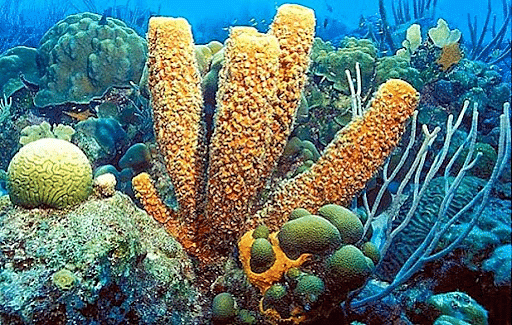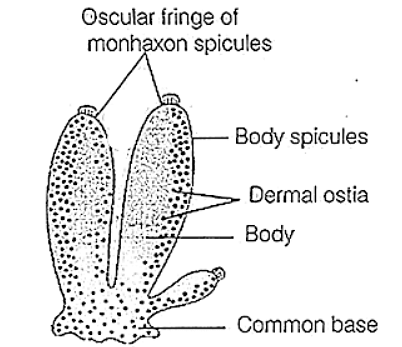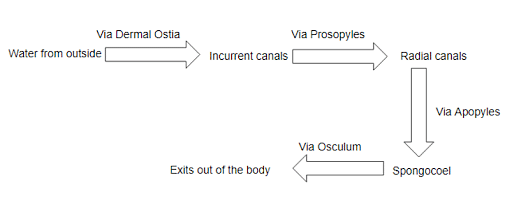
Jasmine Grover Content Strategy Manager
Content Strategy Manager | Updated On - Jul 25, 2025
Sycon is a marine sponge which is widely distributed in shallow waters. Sponges are members of the Phylum Porifera. Typically, by virtue of their structures, they are found attached to shells, and rocks and are sedentary in nature. Furthermore, they predominantly harbour in temperate regions. Furthermore, there are approximately 5000 living species of sponges which are present in the world. These are further divided into 3 different groups based on the presence or composition of spicules or spongin. They are- Calcaria, Hexactinellida and Demospongiae.

| Table of Content |
Key Terms: Sycon, Habitat, Canal System, Sponge, Porifera, Sycettidae, Molluscs, Marine Organism, Corals, Spicules
Read More: Animalia Lower Invertebrates
Related Links
What is Sycon?
[Click Here for Sample Questions]
Sycon is a type of marine sponge which is commonly found attached to the rocks, corals and shells of molluscs. Sycon is described as a genus of sponges that belong to the family Sycettidae. They belong to and are members of the phylum Porifera.
These organisms are tube-shaped in nature and are often found growing up to 3 inches in height. They are usually white to cream in colour and are found attached to shells and rocks. Furthermore, they thrive in the temperate coastal waters of the world.

Sycon
Classification of Sycon
[Click Here for Sample Questions]
- Phylum: Porifera
- Class: Calcarea
- Order: Heterocoela
- Family: Sycettidae
- Genus: Sycon
Sycons are typically small animals, thus they generally range from 2.5 cm to 7.5 cm in height. These tube-shaped structures look like water vessels. In certain cases, they are also referred to as crown sponges as a consequence of the spicules they possess, which are arranged in the form of a crown while in certain other cases, they are referred to as Q-tip or “Pineapple” sponges based on their resemblance to the said item.
Typically, Sycons are delicate in appearance and are organised in an asconoid system wherein the body has a simple tube with possession of a general lack of foldings of the wall of the outer body of the organism.
Read More: Taxonomic Hierarchy of Plants and Animals
Habitat of Sycon
[Click Here for Sample Questions]
Sycons lead a solitary/colonial life. These marine animals are generally found attached to the solid substratum such as shells and rocks of corals and molluscs. Numerous species of sponges placed under this genus generally do not have the tendency to thrive deeper in the ocean. Thereby, Sycons thrive well in slow-wave and low tides. Additionally, they are also commonly found on the underside of rocks in comparatively protected areas amongst hydroids, bryozoans, and other entities. Moreover, some species of Sycons also grow as seaweeds.
Structure of Sycon
[Click Here for Sample Questions]
There is the presence of a great diversity observed in the form of sponges. It ranges from simple to more complicated entities. However, they can still be categorised as intermediate in the case of structural diversities.
Sycon possesses branched cylinders which are connected at the basal end to the solid substratum. Their body is flexible enough even though it is secured firmly. A closer look at these animals reveals the presence of many tiny Ostia or inhalant pores. The free end of every cylindrical branch has an opening at the summit known as an osculum.
Sycon’s bodies are fringed with calcareous monaxon spicules or oscular fringes which modulate the entry of foreign substances into the body. Also, the body below the osculum is narrow which forms the collar region. Furthermore, the surface of the body has elevations which emerge as spicules (oxeotes), thus rendering the bristle-like appearance of the organism.

Structure of Sycon
Read More: Animal Kingdom Animalia Subphylum
Characteristics of Sycon
[Click Here for Sample Questions]
The following are the characteristics which are commonly observed in the case of Sycons:
- The length of the body of the organism varies from 2.5 centimetres to 7.6 centimetres.
- Their bodies are either radially symmetrical or asymmetrical.
- They have the capability to regenerate their lost body parts.
- Needle-like spines called spicules cover their body which gives it a bristle-like appearance.
The Canal System of Sycon
[Click Here for Sample Questions]
Sycons exhibit a canal system which is unique to them. It exists in the body in the form of water channels. The body of Sycon is an organised structure of the complex network of canals and pores, which goes on to form the canal system.
The canal type which is predominantly seen in Sycon is Syncoid Stage I type, which is relatively more advanced than the asconoid canal system. In this system, the Ostia opens up into a central cavity via a system of canals. Here, the central cavity present in the body is known as spongocoel.
Composition of the canal system:
- Ostia: These are the dermal pores which are lined by thin membranes. These possess two openings in which one is used for entry and one for exit.
Additionally, the closing and opening of Ostia for water flow are regulated by myocytes - Sponogocoel/Paragastric or Gastral Cavity: Osculum leads to a large central canal known as spongocoel. This osculum is then engirdled by a layer of cells which is known as myocytes acting as sphincters. They are contractile in nature. Spongocoel seems to appear open to the outside through the osculum
- Radial Canals: These are the evaginations of the body wall. The outer end is closed whereas the inner end of the radical canal is openly mediating with the spongocoel via the excurrent canal.
- Incurrent Canal: It is a tubular structure which is found between two successive radial canals. Thus, it is alternately arranged. Ostia is located on the pore membrane engaged by contractile myocytes acting as sphincters, thus keeping a check on the openings.
- Prosopyles: These minute pores are found between the radial and incurrent canals. Each of these pores is considered an intercellular channel in Sycons, through which, the incurrent canals open into the radial canals in order to mediate with the spongocoel and are wide and short canals whose walls are lined by pinacocytes.
- Apopyles: Apopyles are engirdled by contractile myocytes. They are the openings of the radial canals in spongocoel.

Current of Water Through the Body of Sycon
Water circulation in Sycon follows the route wherein the water travels into the body through the innumerable Ostia present along the external surface, each of which ultimately leads to the incurrent canal. Now, the water flows into the radial canal through the prostyle. Then, from the radial canal, the water gushes into the spongocoel through the apopyles. Hence, the spongocoel is the shared chamber into which all the radial canals of the body are open.
Ultimately, the spongocoel opens to the outside through the osculum [aperture]. Thereby, it can be summarised that water enters through numerous Ostia into the body of the sponge but exits through the osculum, which is a single opening.
Furthermore, in the radial canals, the planar beating of the flagella of choanocytes generates a current that simultaneously draws in water and gushes it out of the body.
Read More: Animal Kingdom Important Questions
Microscopic Organization of Sycon
[Click Here for Sample Questions]
A microscopic view of the body of the organism shows the presence of a single layer of cells which covers the outer surface [dermal layer]. It is from these single cells that the spicules appear to emerge. The layer also possesses pinacocytes.
Spongocoel consists of a lining of flattened endodermal cells while the radial canal is lined by unique collar cells, each possessing flagellum (a long whip-like structure).
There is the presence of collar cells or choanocytes. Each choanocyte is oval or round shaped exhibiting their roles as vacuoles in their cytoplasm.
Flagellum arises from the basal granule associated with the rhizoplast. The collar-like projections consist of cytoplasmic tentacles, their number ranges from 20-30. The skeleton of Sycon is made up of spicules that arise from the scleroblasts and are organised to safeguard the delicate parts of the body of the organism. A common observance is the presence of triradiate or triradiate spicules.
Read More: Difference between Cilia and Flagella
Things to Remember
- Sponges are referred to as the members of the phylum Porifera.
- Sycon is a type of sponge which is generally marine in nature and is mostly asymmetrical in nature.
- Sycon possesses a water transport canal system wherein the water enters via the minute pores [ostia] in the body wall into the central cavity [spongocoel] from where it goes out through the osculum.
- The Canal system present in Sycon is helpful in gathering food, respiration and removal of waste in sycon via water transport.
- The length of Sycon varies from 2.5 to 7.6 cm and they have the capability to regenerate their lost body parts.
- Sycon possesses needle-like spines which are referred to as spicules which cover the entire body of the organism.
Sample Questions
Ques. What is Sycon Ciliatum? (3 Marks)
Ans. Sycon ciliatum is a sycon species (calcareous sponge) which belongs to the family Sycettidae phylum.
Its specifications are as follows:
- Kingdom - Animalia
- Phylum - Porifera
- Class - Calcarea
- Order - Leucosolenida
- Family - Sycettidae
- Genus - Sycon
It is a kind of small purse sponge which grows singly or in a small group from a single holdfast. Its length is upto 5 centimetres. It consists of a covering of fine papillae on its body surface. This gives it the furry look. Its skeleton consists of tangential layers of triactines and tetractines. This species is different from the other species because, in this, the choanocyte chambers are free from each other and are not fused. It is more commonly found along the coasts of Europe and also on the eastern fringes of the Atlantic Ocean.
Ques. List out the various points of differences existing between Sycon and Hydra. (3 Marks)
Ans. Sycon and hydra differ from each other in the following ways:
- Sycon belongs to the phylum Porifera (which shows cellular-level organisation) whereas Hydra belongs to the phylum Coelenterata (which has tissue-level organisation).
- Sycons are asymmetric whereas hydra is radially symmetric.
- Sycons are mostly marine animals (a few of them are also freshwater organisms) but Hydra is always a freshwater organism.
- Sycons consume tiny organic particles that float in the water while Hydra is carnivorous and eats small insects and other small organisms in the water.
- Sycons do not have a mouth whereas hydra does.
- Sycons are found in deeper levels of water than the hydra plants.
Ques. What are the various difficulties that you would face while classifying animals if common fundamental features are not taken into general consideration? (3 Marks)
Ans. The common fundamental features which are used for classifying animals include body symmetry, arrangement of cells, nature of coelom, and level of organisation. Animal classification would become very confusing if the fundamental features are not taken into consideration.
- Animals having different levels of the organisation would have been placed in the same group as sponges and cnidarians.
- Animals displaying different types of germinal layers would have been placed together, as diploblastic cnidarians and triploblastic Platyhelminthes.
- Animals having different body symmetries would have been placed together, as in the case of coelenterates with radial symmetry and Platyhelminthes with bilateral symmetry.
- There would have been no classification of animals based on the presence or absence of the body cavity.
- The placement of oviparous and viviparous animals together.
Ques. Explain the usefulness of the study of the nature of the body cavity and coelom in the classification of animals. (3 Marks)
Ans. Organisms can be classified according to the presence or absence of the coelom. The body cavity, lined by mesoderm, is referred to as coelom. Animals who possess coelom are called coelomates, for example, annelids, molluscs, arthropods, echinoderms, hemichordates and chordates.
In certain animals, the body cavity is not usually lined by mesoderm, instead, the mesoderm is present as scattered regions in between the ectoderm and the endoderm. Such a body cavity is called pseudocoelom and the animals possessing them are called pseudocoelomates, for instance, aschelminthes.
For instance, In pseudocoelomates, the body cavity is usually derived from the blastocoel of the embryo. Furthermore, the animals in which the body cavity is absent are called acoelomates, for instance, Platyhelminthes.
Ques. All vertebrates are chordates but all chordates are not vertebrates. Justify the statement. (3 Marks)
Ans. Chordates refer to those animals that possess a notochord (rod-like structure) at some stage of their lives.
- Phylum Chordata is divided into three Subphyla: Urochordata or Tunicata, Cephalochordata and Vertebrata.
- Subphylum Urochordata and Cephalochordata are often referred to as protochordate and are predominantly exclusively marine.
- In Urochordata, the notochord is present only in the tail of the larva and disappears in adults, while in Cephalochordata, it extends from head to tail region and persists throughout life.
- The members of Subphylum Vertebrata possess a notochord during the embryonic period and are replaced by a cartilaginous or bony vertebral column in the adult. Thus, it can be said that all vertebrates are chordates but all chordates are not vertebrates.
Ques. What are the advantages of a complex canal system? (2 Marks)
Ans. There is an increased surface area for choanocytes in complex sponges. Therefore, a large amount of water moved through the sponge. It increases the filtering capability of the sponge.
Ques. Give water-course through a sycon type canal system. (2 Marks)
Ans. The following is the passage of water through the canal system in Sycon:
Dermal pore — incurrent canal — pore — radial canal — spongocoel — osculum.
Ques. Is a sponge diploblastic or triploblastic? (3 Marks)
Ans. Members of the phylum Porifera are neither diploblastic nor triploblastic because the organisation found in them is cellular. Most of the sponges are asymmetric.
They have 3 layers namely,
- Dermal Layer-This layer connects the other layers and the nutrition absorbing parts etc.
- Gastral Layer- It consists of highly specialised flagellated cells called choanocytes.
- Mesohyl- Also known as mesenchyme or as mesoglea, mesohyl is a gelatinous matrix within a sponge.
Even though there is the presence of 3 layers; however, none of the layers acts as a tissue.
Ques. Elaborate upon the function of the sycon type of water current. (3 Marks)
Ans. In calcareous sponges, the sycon type of water current system is found. It is characterised by choanocytes which surround fingerlike projections (belonging to the sponge wall). Through pores, water directly enters the projection. It further makes its way into the central cavity (spongocoel). Post that, it leaves out the way of the osculum. Hence, it helps the sponges in their proper functioning and enables the sponges to survive.
Also Read:
| Related Links | ||
|---|---|---|
| Invertebrates | Animal Kingdom MCQs | Phylum Hemichordata |
| Gemmule Formation | Difference Between Chordates and Non-Chordates | Phylum Arthropoda |
| Benthic Zone | Coelom | Phylum Annelida |
Also Read:







Comments